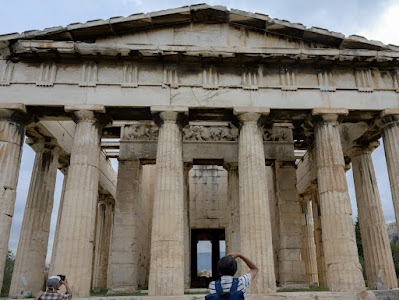California 14th November, safety at sea
After our fantastic foggy start to the day we got to the lighthouse as the mist cleared and the sun shone. Point Reyes is the windiest place on the north American coast (in the spring winds can reach up to 130mph velocity) and the second foggiest. Not surprisingly many ships were wrecked off it's shore trying to get into San Francisco harbour. The lighthouse was built in 1870, after blasting an area 300ft below the cliff to try and lower the lighthouse under the level of the normally high fog. A fog signal was built as well.
On the day of the San Francisco earthquake in 1906 the lighthouse moved north around 18ft. The only damage was that the lens came off it's rail and the lighthouse keeper manage to effect repairs so that it was up and working by the next day.
The manned lighthouse was in operation until 1975 when an automatic light was installed.
The consequence of the lighthouse being lowered is that you have to negotiate a half mile walk from the car park followed by 308 steps down, which is all very well, but you have to return up as well. The lady manning the desk at the lighthouse had her lunch with her so she did not have to go back to her car!
On the day of the San Francisco earthquake in 1906 the lighthouse moved north around 18ft. The only damage was that the lens came off it's rail and the lighthouse keeper manage to effect repairs so that it was up and working by the next day.
The manned lighthouse was in operation until 1975 when an automatic light was installed.
The consequence of the lighthouse being lowered is that you have to negotiate a half mile walk from the car park followed by 308 steps down, which is all very well, but you have to return up as well. The lady manning the desk at the lighthouse had her lunch with her so she did not have to go back to her car!
I became rather absorbed by the rocks on the way down, and up. The cliffs are sandstone and the rocks have been weathered into wonderful shapes.
After we had dragged ourselves up to the top of the stairs we found a man with a large camera looking to spot a common murre, a bird that looks a bit like a guillemot. We scanned the horizon but the common murre was not so common and the closest we got was the sign below.
Giving up pretty quickly we took the car a short distance to Drakes Bay where we could see in the distance an elephant seal colony. The following couple of pictures were taken with a 70-200mm lens and a 1.4 teleconverter. The seals were either lying around like giant slugs or sparring in the water.
In spite of the lighthouse there were still numerous shipwrecks along the coast and spectators watched helplessly from the shore as sailors and passengers died in the surf. So, in 1927 a lifeboat station was built and a full-time watch was kept along the strand so that help could be got immediately to endangered sailors. It sits on the side of Drakes Bay opposite the seal sanctuary.
The dock of the lifeboat station had a number of seabirds and pelicans on it and overhead a hawk flew. I think it is the northern harrier by the shape of the wings although it may be a peregrine falcon.
Finally we walked down the peninsula taking the ' dangerous' path which led close to edge of the cliff and for which the national park would take no responsibility! In fairness the cliffside are pretty crumbly and one of the rock formations underneath subsided this March killing someone. We did have some stunning views up the length of the peninsula to a guano strewn rock at the end.
I will place the end of the day in another blog as this is getting quite long.


































Comments
Post a Comment